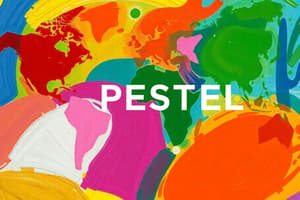Podcast
Questions and Answers
What are key nonmarket strategies that organizations utilize?
What are key nonmarket strategies that organizations utilize?
- Cost reduction and efficiency
- Investment and divestment
- Lobbying and public relations (correct)
- Product development and marketing
Which factor is identified as a significant variable in analyzing political importance?
Which factor is identified as a significant variable in analyzing political importance?
- Technological advancements
- Exposure to civil society organizations (correct)
- Availability of natural resources
- The economic status of a country
What type of environment does the defense industry operate in?
What type of environment does the defense industry operate in?
- A highly politicized environment with significant state involvement (correct)
- A non-competitive environment dominated by private players
- A low-regulation market with minimal state involvement
- An open market with various competitors
Which industry is noted for being privately run but still facing strong political pressures?
Which industry is noted for being privately run but still facing strong political pressures?
What is a macro risk in political risk analysis?
What is a macro risk in political risk analysis?
Which dimension relates to risks on a country level?
Which dimension relates to risks on a country level?
What role does the state typically play in many countries regarding organizations?
What role does the state typically play in many countries regarding organizations?
What is the relationship between civil society and organizations in terms of political mobilization?
What is the relationship between civil society and organizations in terms of political mobilization?
What defines a central hub position within a network?
What defines a central hub position within a network?
What is the main innovation advantage of broker positions in a network?
What is the main innovation advantage of broker positions in a network?
What characterizes 'small worlds' in network contexts?
What characterizes 'small worlds' in network contexts?
Which factor is NOT considered a primary indicator of innovative activity?
Which factor is NOT considered a primary indicator of innovative activity?
How do hubs maintain their power within a network?
How do hubs maintain their power within a network?
What challenge might an outsider organization face when attempting to penetrate a small world network?
What challenge might an outsider organization face when attempting to penetrate a small world network?
Which statement best describes the role of technology in relation to innovative activity?
Which statement best describes the role of technology in relation to innovative activity?
Why are brokers particularly associated with innovativeness in networks?
Why are brokers particularly associated with innovativeness in networks?
What is one primary way to identify innovative firms according to their activities?
What is one primary way to identify innovative firms according to their activities?
How can the potential impact of patents and scientific papers on technology be measured?
How can the potential impact of patents and scientific papers on technology be measured?
Which of the following is NOT a component of technology roadmaps?
Which of the following is NOT a component of technology roadmaps?
What is an example of a challenge organizations might face regarding pollution obligations?
What is an example of a challenge organizations might face regarding pollution obligations?
What does product stewardship involve?
What does product stewardship involve?
Which factor can create opportunities despite the costs imposed by environmental regulations?
Which factor can create opportunities despite the costs imposed by environmental regulations?
What is a significant advantage of having clean processes for supply and production?
What is a significant advantage of having clean processes for supply and production?
Which of the following best describes citation analysis in the context of technological innovation?
Which of the following best describes citation analysis in the context of technological innovation?
Which of the following terms describes changes that are slow to form but can influence other activities over time?
Which of the following terms describes changes that are slow to form but can influence other activities over time?
What is alternative futures forecasting primarily concerned with?
What is alternative futures forecasting primarily concerned with?
Which concept refers to moments where existing trends can abruptly change direction?
Which concept refers to moments where existing trends can abruptly change direction?
What is the main purpose of scenarios in forecasting?
What is the main purpose of scenarios in forecasting?
Which of the following best describes weak signals?
Which of the following best describes weak signals?
Which of the following options illustrates an alternative futures scenario related to a country potentially exiting a currency union?
Which of the following options illustrates an alternative futures scenario related to a country potentially exiting a currency union?
What distinguishes scenarios from strategies in the context of forecasting?
What distinguishes scenarios from strategies in the context of forecasting?
During which condition is scenario analysis typically employed?
During which condition is scenario analysis typically employed?
What is the significance of understanding informal norms in different countries?
What is the significance of understanding informal norms in different countries?
What is the main focus of a PESTEL analysis?
What is the main focus of a PESTEL analysis?
Which forecasting approach indicates high certainty about future conditions?
Which forecasting approach indicates high certainty about future conditions?
How might social changes discourage car use impact supermarkets?
How might social changes discourage car use impact supermarkets?
What characterizes range forecasting?
What characterizes range forecasting?
Why is it essential for strategic decisions to involve forecasting?
Why is it essential for strategic decisions to involve forecasting?
What is limiting about overwhelming details in a PESTEL analysis?
What is limiting about overwhelming details in a PESTEL analysis?
Which of the following accurately reflects the impact of environmental factors on industries?
Which of the following accurately reflects the impact of environmental factors on industries?
What is a primary purpose of conducting a macro-environmental analysis?
What is a primary purpose of conducting a macro-environmental analysis?
Which of the following factors is NOT considered a nonmarket element in the PESTEL analysis?
Which of the following factors is NOT considered a nonmarket element in the PESTEL analysis?
What does PESTEL analysis primarily focus on?
What does PESTEL analysis primarily focus on?
Which example represents a megatrend mentioned in the content?
Which example represents a megatrend mentioned in the content?
Which of the following is an example of a weak signal in macro-environment analysis?
Which of the following is an example of a weak signal in macro-environment analysis?
Which statement about industry or market competition is correct?
Which statement about industry or market competition is correct?
Why can't the future be predicted perfectly, according to the content?
Why can't the future be predicted perfectly, according to the content?
In the context of an organization like Renault, what aspect must be analyzed?
In the context of an organization like Renault, what aspect must be analyzed?
Flashcards
Macro-environment
Macro-environment
The external factors that can influence an organization's success, such as economic, social, political, technological, environmental, and legal factors.
Industry
Industry
The group of companies that produce similar products or services.
PESTEL analysis
PESTEL analysis
The analysis of the macro-environment using the categories of political, economic, social, technological, environmental, and legal.
Forecasting
Forecasting
Signup and view all the flashcards
Megatrends
Megatrends
Signup and view all the flashcards
Inflexion point
Inflexion point
Signup and view all the flashcards
Weak signals
Weak signals
Signup and view all the flashcards
Scenario analysis
Scenario analysis
Signup and view all the flashcards
Central Hub Positions
Central Hub Positions
Signup and view all the flashcards
Broker Positions
Broker Positions
Signup and view all the flashcards
Small Worlds
Small Worlds
Signup and view all the flashcards
Disruptive Technology
Disruptive Technology
Signup and view all the flashcards
Research & Development Budgets
Research & Development Budgets
Signup and view all the flashcards
Patenting Activity
Patenting Activity
Signup and view all the flashcards
New Product Development
New Product Development
Signup and view all the flashcards
Adaptability and Flexibility
Adaptability and Flexibility
Signup and view all the flashcards
Nonmarket Strategies
Nonmarket Strategies
Signup and view all the flashcards
Political Risk Analysis
Political Risk Analysis
Signup and view all the flashcards
Role of the State
Role of the State
Signup and view all the flashcards
Exposure to Civil Society
Exposure to Civil Society
Signup and view all the flashcards
Macro Political Risks
Macro Political Risks
Signup and view all the flashcards
Micro Political Risks
Micro Political Risks
Signup and view all the flashcards
Internal Political Risk Analysis
Internal Political Risk Analysis
Signup and view all the flashcards
External Political Risk Analysis
External Political Risk Analysis
Signup and view all the flashcards
Informal Norms
Informal Norms
Signup and view all the flashcards
Varieties of Capitalism
Varieties of Capitalism
Signup and view all the flashcards
Key Drivers of Change
Key Drivers of Change
Signup and view all the flashcards
Single-Point Forecasting
Single-Point Forecasting
Signup and view all the flashcards
Range Forecasting
Range Forecasting
Signup and view all the flashcards
R&D Spending Analysis
R&D Spending Analysis
Signup and view all the flashcards
Patent Analysis
Patent Analysis
Signup and view all the flashcards
Citation Analysis
Citation Analysis
Signup and view all the flashcards
Media Coverage Analysis
Media Coverage Analysis
Signup and view all the flashcards
Technology Roadmap
Technology Roadmap
Signup and view all the flashcards
Environmental Regulations
Environmental Regulations
Signup and view all the flashcards
Product Stewardship
Product Stewardship
Signup and view all the flashcards
Direct Pollution Obligations
Direct Pollution Obligations
Signup and view all the flashcards
Probability-based forecasting
Probability-based forecasting
Signup and view all the flashcards
Alternative futures forecasting
Alternative futures forecasting
Signup and view all the flashcards
Alternative futures forecasting
Alternative futures forecasting
Signup and view all the flashcards
Scenarios
Scenarios
Signup and view all the flashcards
Study Notes
Business Strategy (2024/2025)
- The business environment creates both opportunities and threats for organizations.
- Examples of how environments impact organizations include: Canal+ or SKY being destabilized by new competitors (Netflix, Amazon, etc.) and Alibaba's rapid growth due to environmental changes (technological progress, Chinese political/economic change, and international regulations).
The Strategic Position: Macro-Environment Analysis
- The macro-environment encompasses broad environmental factors affecting organizations, industries, and sectors—including their significance.
- Industry/sector consists of organizations producing similar products or services, examples include the car industry and pharmaceutical industry.
- Markets and competitors are essential aspects of the macro-environment (e.g., competitors for Renault include Ford, Fiat).
Analyzing the Macro-Environment
- Forecasting, using megatrends, inflexion points, and weak signals
- Prediction emphasis is a critical aspect of forecasting.
- Scenario analysis: emphasizing learning as a key element.
- PESTEL Analysis which includes market and nonmarket factors.
PESTEL Analysis
- Useful for forecasting and scenario development.
- Strategy should consider economic and nonmarket factors.
- Market environment includes suppliers, customers, and competitors.
- Companies compete by sharing resources, revenues, and profits.
PESTEL Analysis: Nonmarket Environment
- Social, political, legal, and ecological factors, influenced by economic factors.
- These factors involve businesses, NGOs, politicians, government departments, regulators, political activists, campaign groups, and the media.
- Organizations need to develop a reputation, connections, influence, and legitimacy. Strategies include lobbying, public relations, networking, and collaboration.
Politics
- Analyzing political factors involves identifying their importance and carrying out a political risks analysis.
- Two key variables for analyzing political factors include the role of the state (as a major economic player) and exposure to civil society organizations (lobbyists, pressure groups, social networks, media).
- Industries highly affected by the state (e.g., defense industry) and those with high exposure to civil society (e.g., food industry).
- Political risk analysis has macro-micro and internal-external dimensions. Macro risks are associated with whole countries (e.g., France).
Economics
- Macroeconomics influence includes fluctuating currencies and interest rates, impacting global economic growth.
- The economic cycle involves regular ups and downs in economic growth, with potential recessions.
- Businesses in discretionary spending industries (e.g., restaurants) are vulnerable to economic downturns.
- High fixed-cost industries (e.g., airlines, hotels, steel) also face challenges during economic downturns.
Social
- Social influences significantly impact the demand and supply within an economic context.
- Demographic trends (e.g., population aging in Western societies) impact markets.
- Geography concentrates industries and markets in specific locations (e.g., the Paris region).
- Changes in wealth distribution impact market sizes—often showing an increase in the wealth of the upper class while reducing the consumption of the middle class.
- Changing cultural attitudes can create challenges for organizations, especially in highly competitive marketplaces.
- Organizational networks are important. Companies interact frequently with other companies within a similar industry.
- Companies can use sociograms to analyze networks and fields of organizations, identifying important social (or economic) connections.
Social - Key Concepts
- Network Density: Interconnections between network members affect effectiveness with more interconnections improving communication flow.
- Central Hub Positions: Organizations connecting multiple network members have significant power.
- Broker Positions: Organizations connecting otherwise separate groups have unique ability to access information and drive innovation.
- "Small Worlds": Most network members are closely connected, providing protection and effectiveness and being difficult for external organizations to penetrate.
Technology
- Emerging technologies (internet, nanotechnology, new composite materials) can affect multiple industries.
- Technologies such as internet streaming can open opportunities for some companies while challenging others (such as traditional music and broadcasting companies).
- Research and Development budgets are a key indicator of innovative activity.
- Patents are crucial in identifying technological breakthroughs.
- Citation analysis, new announcements, and media coverage are also helpful in tracking innovative activity.
- Technology roadmaps can map out future demands and develop alternative technologies to meet these demands.
Ecological
- Environmental issues, including pollution, recycling, and global warming, pose challenges for organizations.
- Environmental regulations (e.g., pollution controls) can impose additional costs.
- Direct pollution obligations involve safely disposing of waste by-products and minimizing pollution.
- Product stewardship emphasizes responsibility for the ecological impact throughout a product's entire life cycle.
- Sustainable development refers to managing environmental effects indefinitely into the future, especially avoiding resource over-exploitation.
- Environmental context is an important source of pressure and is viewed as visible and emotional. High levels of interconnectivity in the organization field increase ecological issues.
- Internal organization and leadership values help shape the organization's response.
Legal
- Legal constraints ('rules of the game') include labor, environmental, consumer regulations, taxation, and corporate governance.
- Deregulation creates new opportunities for some companies (such as low-cost airlines and schools).
- Informal norms/rules that vary between countries are also important to consider (e.g., varieties of capitalism).
Key Drivers
- PESTEL analysis provides potentially complex issues to be considered.
- Categorization of factors doesn't require rigid classifications—a focus on key drivers that affect specific industries is more manageable.
- Consideration of social, and political contexts is critical to identifying high impact factors.
Forecasting
- Strategic decisions require forecasting future conditions and outcomes. Predictability in strategy is necessary when resources are allocated.
- Forecasting approaches are based on uncertainty.
- Different forecasting approaches include single-point, range, and alternative futures.
Directions of Change
- Megatrends are slow-forming changes that have broad influence.
- Inflexion points are shifts in trend direction (usually sudden and significant).
- Weak signals are early signs of future trends.
Scenarios
- Scenarios are alternative views of how the macro-environment might develop, generally focused on the long term.
- Scenario analysis helps managers deal with uncertainty by exploring alternative future environments.
- Developing scenarios avoids presenting alternatives in explicit probabilities.
- The process is used to learn about possible inter-related environmental factors.
The Scenario Process
- Defining scope, key drivers, developing distinct scenarios, identifying impacts, and monitoring progress.
International Trading Relationships
- Complex relationships between countries are fluid. Factors of trust between countries, monopolies, and the desire for a business diversity play a critical role.
Studying That Suits You
Use AI to generate personalized quizzes and flashcards to suit your learning preferences.




